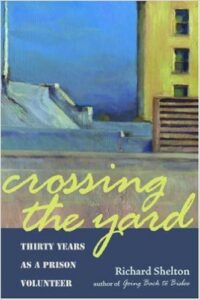Category: Diversity, Fairness, and Access
-
BOOK REVIEW: The Color of Law by Richard Rothstein
“An unjust law is no law at all.” —St. Augustine
This quote from St. Augustine says it all for me after reading Richard Rothstein’s well-researched book The Color of Law (AMAZON). As an educator who spent the last 10 plus years working for the courts, where the rule of law reigns supreme, this book challenged what I thought I knew about segregation, racism, public housing and the law. As such, this enlightening book is valuable to judges and court employees for understanding who comes to court and how they get there.
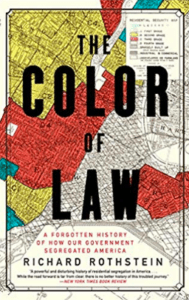 Richard Rothstein’s thesis is that local, state, and federal laws, rules and policies deliberately caused segregation in public housing, beginning primarily around World War II when severe housing shortages for war workers caused the government to build public housing in large numbers where war industries existed. While the common supposition is that housing segregation is de facto (people live in segregated neighborhoods out of personal choice), Mr. Rothstein argues that segregation in housing is in fact de jure (a result of laws and policies of the government). His arguments are compelling and are a lesson for everyone in the court system, in fact for all citizens, about why housing segregation really happened, and what might be done about it.
Richard Rothstein’s thesis is that local, state, and federal laws, rules and policies deliberately caused segregation in public housing, beginning primarily around World War II when severe housing shortages for war workers caused the government to build public housing in large numbers where war industries existed. While the common supposition is that housing segregation is de facto (people live in segregated neighborhoods out of personal choice), Mr. Rothstein argues that segregation in housing is in fact de jure (a result of laws and policies of the government). His arguments are compelling and are a lesson for everyone in the court system, in fact for all citizens, about why housing segregation really happened, and what might be done about it.While currently most public housing is targeted towards the poor, in its early days, public housing was built for working- and middle-class families. Since few houses were constructed during the Depression, a huge shortage of housing developed in the 1930’s. When the economy ramped up with as WWII began, millions of workers, both white and African-American, migrated to cities where those factories offered work. The government invested in public housing to provide war workers with homes. But rather than make this housing available to all workers in all areas, the laws passed by Congress and the policies of the Public Works Administration, and later the Federal Housing Authority, required subdivisions to be segregated. The 1949 Federal Housing Act, which Mr. Rothstein calls the “poison pill” of housing legislation, affirmed segregation practices in law. In addition, many more white subdivisions were built than African-American subdivisions, forcing black people into crowded conditions or dwellings far from their work sites as they tried to find adequate housing. In addition, black subdivisions tended to be built in less desirable locations, for example, near heavy industry and dumps, where polluted conditions compromised the health of those forced to live there. No other choices were available to them.
In addition, African-American workers were hired only for the most menial and lowest-paying positions, until the dire need for workers forced war industries to hire them for any position for which they had the aptitude. But the greater pay these workers earned did not allow them access into white subdivisions even when they could afford to live there.
According to Mr. Rothstein, and supported in public record, the results of forcing segregation where it had previously not existed or was minimal, like in California, were many, and continue to exist and harm African-Americans today. In addition to negative health conditions mentioned above, another result of forced segregation was overcrowded neighborhoods which turned into slums. With housing for African-Americans in short supply, families subdivided their homes and took in renters, multiple families shared homes, and the resulting overcrowding caused neighborhoods to go downhill. In addition, housing segregation reinforced school segregation, and black schools were underfunded and inferior to white schools. Since black families could not buy houses that they could afford in better neighborhoods, they were not able to accumulate wealth and education the way white families could, a disparity that continues today. Mr. Rothstein explains clearly how government-sanctioned housing segregation negatively impacted, and continues to negatively impact, black families in areas of health, achievement gaps, wealth disparities, and mass incarceration.
As an example of how housing segregation continues to hurt African-American families, Mr. Rothstein shows how in the time prior to the great recession of 2008-2009, lenders targeted low-income people and African-Americans (both working- and middle-class) for toxic mortgages in far greater numbers than middle class white Americans. When the recession occurred, these families lost most of the wealth they had earned over decades. African-Americans who lost their wealth with their homes far exceeded white Americans in the same situation.
Mr. Rothstein finishes his book with possible remedies to the continued discrimination against African-American families. His solutions are sometimes radical, a fact he admits. As one example, he cites the gentrification of older neighborhoods around city centers. Mr. Rothstein states that while gentrification is not necessarily a bad thing, unless something is done to help the poorer neighbors living in these neighborhoods so that they can either upgrade their homes and stay or purchase reasonable housing elsewhere, gentrified neighborhoods end up richer, whiter enclaves and poorer residents end up in slums since those areas are often all they can afford when rents become unaffordable where they used to live.
The Color of Law is rich with well-documented history and details of how public housing became segregated, how it hurt African-Americans, and how it continues to harm them. The fact that this segregation was de jure and not de facto provides a rich area to begin a discussion with judges and other court employees. This book is recommended for all court employees and is an excellent choice for any law and literature class or book club discussion.
 Formerly the Pima County (Arizona) Field Trainer and a Superior Court Training Coordinator, Nancy Smith has over 10 years of experience working in court training and education, first at the Washington State AOC and at Pima County Superior Court (Tucson, AZ). She currently is a partner at Sustainable Change Coaching and Consulting. She came to the courts with 16 years of experience in education, both as a community college instructor and a high school teacher in Tucson, and as a curriculum coordinator at the Evergreen State College in Olympia, WA. Nancy taught many kinds of court related classes, including topics such as implicit bias and faculty development, and court related topics like due process and procedural fairness. She has a special interest in adult learning theory and application. Nancy has branched out into a new business, where she and her partner plan to teach court leaders coaching skills to improve employee performance and retention. She speaks periodically at conferences on topics related to judicial education and publishes articles for the National Association of State Judicial Educators (NASJE). Currently, she serves on the NASJE Board as the Western Region Director as well as on the Communication and Conference Committees. She earned her bachelor’s degree in French and History at the College of William and Mary in Virginia, and her Master’s in French from the Free University of Brussels, Belgium. Nancy grew up in a Navy family, married into an Army family and served four years as an Army Intelligence officer. She has traveled widely around the United States and Europe as well as to Peru, Mexico and China. She likes the outdoors, and swims, hikes, bikes and does yoga for fun and fitness. She can be reached at nancy@sustainablechangecoaching.com.
Formerly the Pima County (Arizona) Field Trainer and a Superior Court Training Coordinator, Nancy Smith has over 10 years of experience working in court training and education, first at the Washington State AOC and at Pima County Superior Court (Tucson, AZ). She currently is a partner at Sustainable Change Coaching and Consulting. She came to the courts with 16 years of experience in education, both as a community college instructor and a high school teacher in Tucson, and as a curriculum coordinator at the Evergreen State College in Olympia, WA. Nancy taught many kinds of court related classes, including topics such as implicit bias and faculty development, and court related topics like due process and procedural fairness. She has a special interest in adult learning theory and application. Nancy has branched out into a new business, where she and her partner plan to teach court leaders coaching skills to improve employee performance and retention. She speaks periodically at conferences on topics related to judicial education and publishes articles for the National Association of State Judicial Educators (NASJE). Currently, she serves on the NASJE Board as the Western Region Director as well as on the Communication and Conference Committees. She earned her bachelor’s degree in French and History at the College of William and Mary in Virginia, and her Master’s in French from the Free University of Brussels, Belgium. Nancy grew up in a Navy family, married into an Army family and served four years as an Army Intelligence officer. She has traveled widely around the United States and Europe as well as to Peru, Mexico and China. She likes the outdoors, and swims, hikes, bikes and does yoga for fun and fitness. She can be reached at nancy@sustainablechangecoaching.com. -
BOOK REVIEW: Crossing the Yard: Thirty Years as a Prison Volunteer
Review written by Nancy Fahey Smith, NASJE Western Region Director and Field Trainer for Arizona Superior Court in Tucson, Arizona.
A couple of times a year, the training division at the Arizona Superior Court in Tucson, AZ, sponsors a book club for continuing education credit, led by NASJE member Nancy Smith. In May of 2016, Club Read members met to discuss the book Crossing the Yard, by Professor Richard Shelton (2007, University of Arizona Press). If ever there was a book perfect for law and literature, for both court staff and for judicial officers, this profoundly compelling memoir about prisons is it.
It is difficult to discuss prison conditions with just about anyone. Some are convinced that crime deserves prison, the more time the better. Others are appalled by statistics that reveal the huge number of prisoners in America. Politicians talk about being tough on crime, parents talk about spending more on education instead of on prisons. Private prisons seem to be having a heyday. Recently, much has been made of the number of minorities in American prisons, and the long sentences they serve compared to Whites. We are scared by recidivism rates, yet unwilling, it seems, to spend scarce resources on programs to prevent it. As court personnel, exposed daily to crimes against society, it is easy to become jaded about prison and prisoners.
Few of us, however, have actually spent any real time in prisons. Perhaps we have had a tour, or maybe even visited a relative or friend there. In reality, we don’t understand what it is like to be in prison.
Unlike most of us, author Richard Shelton has spent many hours and days trying to help prisoners. In fact, he has spent more than 30 years leading creative writing workshops in Arizona’s prisons. Week in and week out he travels to remote and horrifying locations, working tirelessly to develop real writers out of inmates willing to learn. Along the way, he learned that prisoners are people, and many of them are enormously talented people who made bad mistakes in their lives and landed in prison.
Professor (emeritus) of Creative Writing at the University of Arizona in Tucson, Shelton wrote Crossing the Yard, a memoir of his experiences in Arizona prisons and full of stories that will inspire and disgust readers, with the goal of enlightening people to what really goes on inside prisons. He began trekking to the state prison in Florence, AZ after receiving a letter from a particularly infamous prisoner who asked Shelton to critique his writing. While many of Shelton’s adventures are downright scary, others are full of humor and hopefulness. The prisoners in Shelton’s workshops taught him many lessons, especially to be patient, forgiving and kind.
Shelton writes “Oh, these men in orange. I’ve learned more from them than I ever taught them, and it’s been good stuff…They have taught me to be patient; never to whine no matter what; to expect the worst and be happy if I get anything else; to be loyal, to be forgiving, to be kind. They have taught me that we are all law breakers and we are all victims of crime. They have taught me that growing old is no disgrace, but that a youth, wasted in prison, is a disaster.” (p. 227) Several of Shelton’s inmate students became published authors, like Jimmy Santiago Baca and Ken Lamberton, and more than a few became his friends. More often than not, workshop members found a reason for living and for staying out of trouble once released.
What really angers Shelton is the inhumane way prisoners are treated: “I want to put my head down on the table in front of me and weep with a pain that will not be comforted and a rage I cannot express.” (p. 232) He finds prison administrators inept and uncaring; prison policies arbitrary, ineffective, and cruel; the conditions horrible and inhumane; and the bureaucracy impossible. He rages that society simply throws so many people away, when after spending time with them Shelton finds that they are human beings deserving of forgiveness. He is not so naïve to believe that all prisoners are redeemable, but he believes that many are and all should at least be treated with dignity and respect while imprisoned.
Crossing the Yard provoked much soul searching when we discussed it in the Superior Court book club. Members of the group were overall pretty appalled at what they read, and came away with altered perspectives about those they see put away every day in their jobs. The group was surprised at the prevalence of drugs and racism in the prisons, but not really at the number of mentally ill serving time. Shelton’s stories and examples convinced group members that prisoners deserve a second chance to be contributing members of society. Prison does not have to be a place that destroys a person’s humanity, and many prisoners can be redeemed given the chance and the resources. Professor Shelton’s workshops provided just such a resource to its members.
Most of all, Shelton’s book taught group members what prison is really like for most prisoners. The picture is not pretty.
Professor Shelton writes very well and is a wonderful storyteller. The grim stories are interspersed with heartwarming stories of success and plenty of good humor. He also provides a reading list, and those who take the list and read the writing of workshop participants will be amazed at the powerful poetry, prose and art that leap from the pages of their work.
With sentencing reform and prison reform currently on the agenda in many states and at the federal level, a book like Crossing the Yard can serve to illuminate why such reforms are vital. As judicial branch educators, we are always on the lookout for essential learning resources to guide our work. Crossing the Yard by Richard Shelton is one such resource.
NAJSE members can access the discussion questions created for the Book Club discussion in Tucson, as well as a link to a PBS video interview of Professor Shelton on the Members Area of this website.
-
Self-theories: Their Role in Motivation, Personality, and Development
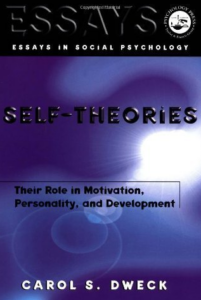 Self-theories: Their Role in Motivation, Personality, and Development (Essays in Social Psychology), 1st Edition by Carol Dweck
Self-theories: Their Role in Motivation, Personality, and Development (Essays in Social Psychology), 1st Edition by Carol Dweck
Get it at AMAZONThis innovative text sheds light on how people work — why they sometimes function well and, at other times, behave in ways that are self-defeating or destructive. The author presents her groundbreaking research on adaptive and maladaptive cognitive-motivational patterns and shows:
- How these patterns originate in people’s self-theories
- Their consequences for the person — for achievement, social relationships, and emotional well-being
- Their consequences for society, from issues of human potential to stereotyping and intergroup relations
- The experiences that create them
This outstanding text is a must-read for researchers in social psychology, child development, and education, and is appropriate for both graduate and senior undergraduate students in these areas.
-
The Art of Changing the Brain: Enriching the Practice of Teaching by Exploring the Biology of Learning
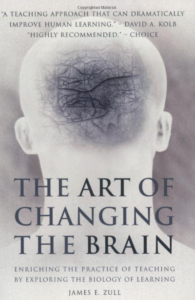 The Art of Changing the Brain: Enriching the Practice of Teaching by Exploring the Biology of Learning, 1st Edition by James E. Zull
The Art of Changing the Brain: Enriching the Practice of Teaching by Exploring the Biology of Learning, 1st Edition by James E. Zull
Get it at AMAZONJames Zull invites teachers in higher education or any other setting to accompany him in his exploration of what scientists can tell us about the brain and to discover how this knowledge can influence the practice of teaching. He describes the brain in clear non-technical language and an engaging conversational tone, highlighting its functions and parts and how they interact, and always relating them to the real world of the classroom and his own evolution as a teacher.
-
Oxford Dictionary of Sociology
Oxford
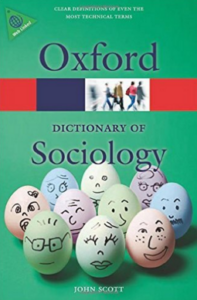 Dictionary of Sociology by John Scott
Dictionary of Sociology by John Scott
Get it at AMAZONA consistent best-seller, the wide-ranging and authoritative Dictionary of Sociology was first published in 1994 and contains more than 2,500 entries on the terminology, methods, concepts, and thinkers in the field, as well as from the related fields of psychology, economics, anthropology, philosophy, and political science. This Dictionary is both an invaluable introduction to sociology for beginners, and an essential source of reference for more advanced students and teachers.
-
Inviting Transformation: Presentational Speaking for Changing the World
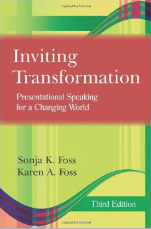 Inviting Transformation: Presentational Speaking for Changing the World by Foss & Foss
Inviting Transformation: Presentational Speaking for Changing the World by Foss & Foss
Get it at AMAZONThe third edition of Inviting Transformation continues to offer a refreshing, innovative approach to public speaking, or what the authors call presentational speaking to acknowledge that not all important speaking occurs in formal public settings. The book introduces readers to invitational rhetoric, a mode of communicating that offers an effective response to the diversity that characterizes the world.
Respect for the diversity of the world also is emphasized in the book in that the traditional speaking model has been expanded to include speaking options that characterize diverse cultural groups. For all of the processes of presenting — such as selecting a speaking goal, organizing ideas, elaborating on ideas, and delivering the presentation — the book includes and validates more inclusive speaking practices.
The exceptionally accessible writing style and reasonable price make this concise text attractive for students and instructors alike.
-
Reaching and Teaching Students in Poverty: Strategies for Erasing the Opportunity Gap
 Reaching and Teaching Students in Poverty: Strategies for Erasing the Opportunity Gap by Paul C. Gorski
Reaching and Teaching Students in Poverty: Strategies for Erasing the Opportunity Gap by Paul C. Gorski
Get it at AMAZONThe author draws from decades of research to deconstruct popular myths, misconceptions, and educational practices that undercut the achievement of low-income students.
He carefully describes the challenges that students in poverty face and the resiliencies they and their families draw upon. Most importantly, this book provides specific, evidence-based strategies for teaching youth by creating equitable, bias-free learning environments. Written in an appealing conversational tone, this resource will help teachers and school leaders to better reach and teach students in poverty.
-
The Divide: American Injustice in the Age of the Wealth Gap
The Divide: American Injustice in the Age of the Wealth Gap by Matt Taibbi
GET IT AT AMAZONBe prepared to be outraged.
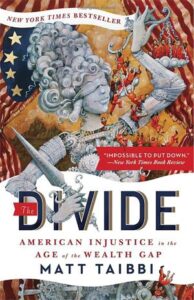 In his compelling book, The Divide: American Injustice in the Age of the Wealth Gap, Rolling Stone editor Matt Taibbi builds a compelling case about inequality in the American criminal justice system, charging that one’s wealth or lack thereof largely affects how one fares in it. Mr. Taibbi demonstrates convincingly how and why Wall Street bankers, traders and hedge fund operators have never been convicted of crimes for their roles in the 2008 recession—and it isn’t pretty. The tableau he paints shows that despite convincing evidence of their crimes, those able to afford expensive lawyers get off without criminal convictions.
In his compelling book, The Divide: American Injustice in the Age of the Wealth Gap, Rolling Stone editor Matt Taibbi builds a compelling case about inequality in the American criminal justice system, charging that one’s wealth or lack thereof largely affects how one fares in it. Mr. Taibbi demonstrates convincingly how and why Wall Street bankers, traders and hedge fund operators have never been convicted of crimes for their roles in the 2008 recession—and it isn’t pretty. The tableau he paints shows that despite convincing evidence of their crimes, those able to afford expensive lawyers get off without criminal convictions.On the other hand, the poor are subject to Broken Windows policing and stop and frisk policies that cause them to be detained and subject to search and arrest for no other reason than being there. Welfare recipients are routinely convicted, jailed, and refused future benefits because of errors in the system, and their homes and belongings searched without just cause. Large segments of the minority and poor populations have criminal convictions and/or have served jail time for truly minor “crimes,” or for no reason at all. According to Mr. Taibbi, this happens because they are poor and powerless—and often because of their race.
The picture Mr. Taibbi paints is disturbing, and the information he provides is indispensable. His arguments show diligent and thorough research. He quotes statistics and well-known social science researchers and members of the Justice Department, as well as members of various police forces and the victims and victors themselves. Just when you think you understand the criminal justice system, this book jars you into realizing how much more there is to learn and to work to change.
The Divide is essential reading for anyone who works in the criminal justice system and would be an interesting (and perhaps controversial) Law and Literature or book club selection.
But, be prepared to be outraged.
-
New Jim Crow: Mass Incarceration in the Age of Colorblindness
New Jim Crow: Mass Incarceration in the Age of Colorblindness by Michelle Alexander
GET IT AT AMAZON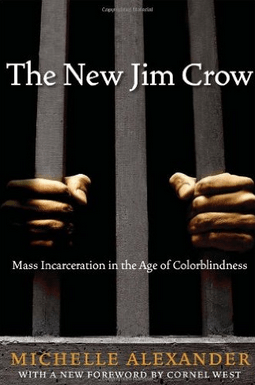 Once in a great while a book comes along that changes the way we see the world and helps to fuel a nationwide social movement. The New Jim Crow is such a book. Praised by Harvard Law professor Lani Guinier as “brave and bold,” this book directly challenges the notion that the election of Barack Obama signals a new era of colorblindness. With dazzling candor, legal scholar Michelle Alexander argues that “we have not ended racial caste in America; we have merely redesigned it.”
Once in a great while a book comes along that changes the way we see the world and helps to fuel a nationwide social movement. The New Jim Crow is such a book. Praised by Harvard Law professor Lani Guinier as “brave and bold,” this book directly challenges the notion that the election of Barack Obama signals a new era of colorblindness. With dazzling candor, legal scholar Michelle Alexander argues that “we have not ended racial caste in America; we have merely redesigned it.”By targeting black men through the War on Drugs and decimating communities of color, the U.S. criminal justice system functions as a contemporary system of racial control—relegating millions to a permanent second-class status—even as it formally adheres to the principle of colorblindness. In the words of Benjamin Todd Jealous, president and CEO of the NAACP, this book is a “call to action.”
